

 |
Catmagicby
|
Catmagic
Published October 1986 (paperback July 1987), written 1983/4
Whitley Strieber – a grand master of bestselling horror (The Wolfen
and The Hunger) and apocalyptic fiction (Warday and Nature’s
End) – joins forces with Jonathan Barry – a talented newcomer
– to present a brilliant novel that stretches the boundaries of both dark
fantasy and horror.
Set in the world of modern American witches, Catmagic is full of action, terror, and wonder, enormously entertaining and profoundly
human.
Maywell, New Jersey, is a sleepy little town,
the forces around it quiet, until in a laboratory George Walker completes his
first experiment in reanimation: He kills an animal and brings it back to life.
Next, he will try a human subject. But before he does, he and the entire town
of Maywell will have to deal with the force his first success unleashes. That
force is determined to prevent George’s envisioned success. The scientist’s
work must not continue. And the work must not interfere with the events waiting
for young Amanda Walker.
Amanda, George’s niece, is an accomplished
illustrator. She’s come to town to meet renowned writing Constance Collier,
hoping to illustrate Collier’s next book. But Amanda is there for someone
else’s hidden purpose, a purpose arising out of desperate need. It is a
need that may require Amanda to enter death itself.
If Amanda succeeds, her life will be changed forever,
in ways strange beyond all human knowing.
But Amanda may not be allowed to live long enough
to make her choice. Brother Simon Pierce, in his Tabernacle of the Risen Lord,
finds himself moved to action against her. The strange object in his pocket
is stirring his own dark history into new life.
That history is far longer than Simon knows.
So is Amanda’s.
The tale is ancient beyond memory, and in those
ages of greatest change it must be relived, in all its fear and hope, its wisdom
and its passion.
One of those times is now.
![]()
From the Hardcover Edition:
Jonathan Barry is an aerospace industry consultant. He is also a practicing witch and has an innate familiarity with the witchcraft movement. He is married and has three children, and lives in New York City.
From the Paperback Edition:
I wrote Catmagic in 1984, well before I was consciously aware of the visitors who figure in Communion.
Communion is a story of how it felt to have personal contact with the visitors. The mysterious small beings that figure prominently in Catmagic seem to be an unconscious rendering of them, created before I was aware that they may be real. It could be that the message of the book – which involves respect for earth and all her creatures, and the seeking of higher consciousness – is somehow derived from my inner understanding of the meaning of the visitors.
The hardcover edition appeared under a pseudonym, Jonathan Barry, primarily because it was published too close to the publication date of another of my books and would have created a conflict. I am the sole author of Catmagic.
Catmagic concerns Witches and Witchcraft, also known as the religion of Wicca. It is about the spiritual path of real Witches. It has nothing to do with tomfoolery like alleged “black magic.” The Witches I met in doing research for Catmagic were no more evil than Christians or Buddhists or Hindus, or the practitioners of any other perfectly legitimate religion, among which Wicca can certainly be numbered. They were good people, passionate in their concern for the welfare of the natural world and the growth of their own souls.
Certainly there are a few people who distort Witchcraft and
mock its ancient rituals in ceremonies that glorify evil. I met
two such people. They turned out to be secretly associated with
another religion. They were calling themselves Witches and engaging
in painfully silly black magic rituals involving dead goats in
an effort to discredit Wicca. Others who do evil in the name of
Witchcraft are mentally disordered or, simply, charlatans. Such
people should no more be counted Witches than practitioners of
the black mass should be considered Catholics.
Catmagic
© 1986 Wilson & Neff, Inc.
Synopsis courtesy of TOR Books
Cover Art by Paul Stinson.
The Relationship Between Communion and Cat Magic
© 1987 Whitley Strieber, courtesy of Whitley Strieber